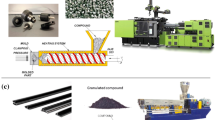Abstract
An integrated approach to magnet lead design is presented which incorporates innovations and design enhancements over a conventional design. The primary innovation is that a set of baffles is used to transfer heat from the leads to the Helium gas, as opposed to direct thermal contact between the two. Based on this design approach, we have established a calculational method to compute boiloff rates and temperature profiles. We have investigated the feasibility of such a baffle cooled approach by conducting boiloff calculations for various lead geometries. Leads with graded cross sectional areas, which are readily incorporated into such a system, significantly lower the boiloff rate compared with uniform area leads.
Similar content being viewed by others
References
V.E. Keilin, E.Y. Klimenko, Investigation into high current leads in liquid helium applications. Cryogenics 6, 222–228 (1966)
K. Efferson, Helium vapor cooled current leads. Rev. Sci. Instrum. 38, 1776–1779 (1967)
R.C. Richardson, E.N. Smith, Experimental Techniques in Condensed Matter Physics in Low Temperatures (Addison-Wesley, Reading, 1988), pp. 30–33, Chap. 2
Cryomagnetics Inc. 1006 Alvin Weinberg Drive, Oak Ridge, Tennessee 37830, (865)482-9551
A. Roth, Vacuum Technology (North-Holland, Amsterdam, 1990), pp. 69–79, Chap. 3
ANSYS Inc., Southpointe 275 Technology Drive Canonsburg, PA 15317, (724)746-3304
Y. Shiroyanagi, G. Gopalakrishnan, S. An, T.J. Gramila, Implementation of a baffle cooled approach for a cryostat magnet lead system, in AIP Conf. Proc. Ser., vol. 850 (AIP, New York, 2006)
Emerson and Cumming, 46 Manning Road Billerica, MA 01821, (978)436-9700
F. Rondeaux, P. Bredy, J.M. Rey, Thermal conductivity measurements of epoxy systems at low temperature. Adv. Cryog. Eng. 48, 197–203 (2001)
Precision Cryogenics Systems Inc., 11717 W. Rockville Rd., Indianapolis, IN 46234, (317)272-0888
C.Y. Ho, M.W. Ackerman, K.Y. Wu, S.G. Oh, T.N. Hovill, J. Phys. Chem. Ref. Data 7(3), 959–1177 (1978)
NIST Standard Reference Database 69, June 2005 Release: NIST Chemistry WebBook. http://webbook.nist.gov/cgi/fluid.cgi
Y.S. Touloukian, Thermal Conductivity: Metallic Elements and Alloys (IFI/Plenum, New York, 1970), pp. 1164–1175
G.K. White, Experimental Techniques in Low-Temperature Physics (Oxford University Press, London, 1979), p. 137, Chap. 5
S.Y. Seol, J.R. Hull, M.C. Chyu, IEEE Trans. Appl. Supercond. 5(2), 785–788 (1995)
H.G. Lee, H.M. Kim, B.W. Lee, I.S. Oh, H.R. Kim, O.B. Hyun, J. Sim, H.M. Chang, J. Bascunan, Y. Iwasa, IEEE Trans. Appl. Supercond. 17(2), 2248–2251 (2007)
Author information
Authors and Affiliations
Corresponding author
Rights and permissions
About this article
Cite this article
Shiroyanagi, Y., Gopalakrishnan, G., An, S. et al. A Novel Approach for Magnet Leads. J Low Temp Phys 155, 127–152 (2009). https://doi.org/10.1007/s10909-009-9863-5
Received:
Accepted:
Published:
Issue Date:
DOI: https://doi.org/10.1007/s10909-009-9863-5




